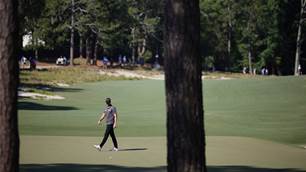It’s long been decreed by those dungeon masters of the United States Golf Association that U.S Open venues must have super-thin fairways and thick, chunky, chop-it-sideways rough. Thus, the first two times Pinehurst No.2 hosted the national championship (1999 and 2005), it was a beast more penal than Pentridge. Yet the USGA appears to have mellowed, and bucked the trend of punishment for the sake of it. And it’s been Pinehurst at the vanguard. And this year's U.S Open should be entertaining indeed.
Chi Chi's Idea
It was Chi Chi Rodriguez’s idea, but Lon Hinkle did it first – turn the 545-yard double-dog-leg par-5 eighth hole at the Inverness Club into a two-shotter by hitting the tee shot onto the neighbouring 17th fairway. It was the first round of the 1979 U.S Open. It so enraged the United States Golf Association they changed the hole mid-competition. It became all that Hinkle is remembered for.
What happened was this: Rodriguez said to Hinkle, “I found a shortcut and I’m going to cut 100 yards off the hole.” Hinkle liked the idea and was first up. He hit one-iron onto 17, two-iron onto eight green, two-putted, simple birdie. It helped him into a share of the lead (-1). The tee shot was the subject of reporter questioning post-round.
On the Friday Hinkle was surrounded by reporters again, this time in the locker room before his round. He was told that a spruce tree had magically appeared near the eighth tee, planted in the dead of night to block the path to the 17th fairway.
Hinkle thought it was hilarious. He played up to reporters and took the piss out of the USGA. Said stuff like, “No tree can hold me!” And that one didn’t, for it was but a straggly old thing which Hinkle easily cleared. He made birdie again – driver, six-iron, two-putts. Stick that in your pipes, sportscoats.
Hinkle would chop it around otherwise and end up 20 shots behind eventual winner Hale Irwin, who was more the USGA’s kind of guy. Serious face, steel mind, hit it straight, repeat. He wore glasses. And braces. He was the straightest hitter on the PGA Tour and Inverness would be the second of his three major championships, wedged between the U.S Opens of 1974 and 1990.

Punishment was long the USGA way. U.S Open courses had to sport skinny fairways, chop-it-sideways rough, tee-boxes set back ever-more prodigious distances. There would be one way to play these holes, and that was to hit the middle of the designated fairway. And the bastards would put bollards in the way if anyone digressed.
Yet the USGA, it appears, has bucked the trend in the last decade or so. And it’s been Pinehurst No.2 at the vanguard.
No.2
It worked for Penfold’s Bin 28, Chanel No.5 and that gang of Disney dwarves – just call the thing what it is. Pinehurst No.2 was named with all the creativity of a forensic audit and is one of nine similarly named courses on the 800-hectare Pinehurst Resort in North Carolina.
No.2 was designed by Donald Ross, opened for play in 1907 and is one example of his signature upturned saucer greens. Over the years the club’s committee types, prepping their baby for a visit by the USGA, heaped so much blood-and-bone into the rough, it created a beast more penal than Pentridge.
The Pinehurst people knew the USGA wanted Open courses to be really, really hard. The USGA was about heaping pain upon professional golfers at their annual U.S Open. These are people who like golf courses to come with the equivalent of nipple cramps and hot wax.
They even had their own “doctor” – Robert Trent Jones – who’d be drafted in to make potential courses harder and thus suitable for U.S Opens. The plan was, effectively, thicken rough so it’ll swallow a ball, narrow the fairways, grow the long stuff almost right to the green.
And thus, after committees had had their way and Trent Jones his, when the worthies of the USGA visited in the early ’90s, they were all over Pinehurst No.2. This place is really hard, they thought. Nothing a river of lava couldn’t improve, of course. But hashtag respect, Pinehurst curators. Hashtag respect.
In 2010, however, in a nod to modernity and progress, Pinehurst called in Bill Coore and Ben Crenshaw, whose plan was to return No.2 to Donald Ross’ less-penal original layout. More like their masterpiece Lost Farm at Barnbougle, less like a fist-fight in a hurt locker. It would still be challenging to score well, but there wouldn’t be only one way to play it.
They ripped out the rough, replaced it with sandy waste and tussocks of wiregrass, and returned the course to something better resembling Ross’ original, open design, which he said was “the fairest test of championship golf I have ever designed”.
Today, No.2 looks like flat Augusta, but with sandy waste and furry tussocks. There is pine straw under pine trees. Course architect and gun amateur Lukas Michel says it’s a beacon for sustainable golf in the world.

Michel is uniquely qualified to comment. He first played Pinehurst in the famous North and South Amateur Championship. When he won the 2019 U.S Mid-Amateur Championship and a place in the (November, Covid-delayed) Masters, he spent two weeks at Pinehurst honing his game. Today, he’s a Golf Course Design Associate with Clayton, DeVries and Pont, and one of the grasshoppers of Golf Australia magazine architecture editor, Mike Clayton.
Michel says No.2 “looks easy to the eye”.
“When you first look at it and play it, you stand on the tee and it’s relatively wide. It does tend to pinch where the long hitters hit it. But my first impression was, not too difficult – none of the rough or vegetation is so penal you can lose the ball,” Michel says.
“And then you start playing it and you realise it’s a little harder than it looks. Particularly around the greens.”
SHORT GRASS
Ah yes, Ross’ famous “upturned saucers”; elephant graveyards in the Himalayas. Michel reckons over the years they’ve become bigger. He also reckons it wasn’t Ross’ original intention to make them so elephant-like, nor that the greens should be Ross’ ‘signature’.
“Everyone talks about the raised greens with all the run-offs; they call them ‘typical Ross greens’. In fact, Ross didn’t build greens typically like that. His work at No.2 is more of an exception,” Michel says.

“The character of Pinehurst’s greens has come more from evolution. Over time the greens have built up with top dressing and they’ve probably gone upwards at least a foot in height.
“When Coore and Crenshaw did the renovation, they didn’t actually do any work to lower them back down because they were so distinctively raised and so tricky that they left them.
“The difficulty of the golf course is something that’s evolved over time.”
LONG GRASS
No.2 has rough, but it’s not the typically thick, lush, weedy goodbye-golf-ball, bluegrass that you find at Winged Foot or Oakmont, or any of the “classic” parkland U.S Open tests. Rather, No.2 sports Bermuda, which Aussies would be familiar with, according to Michel, because couch is a form of that.
“In the renovation, they put in a bunch of wiregrass and open sandy areas. So it’s still very penal off the tee if you miss, but probably not as much as lush, long, green rough is.
“What it does bring, though, is an element of randomness. You can hit it into a sandy waste area and have a pure lie and a line to the flag. Or you could be right under some wiregrass with no control over where it’s going to go.
“It’s probably not as ‘demanding’ off the tee as other U.S Open venues, but it can still penalise harshly if you miss.”
Michel says Payne Stewart (1999) and Michael Campbell (2005) won U.S Opens at “old Pinehurst”.
“It was lots of Bermuda grass rough. Lots of pine trees. Like The Australian before its renovation,” Michel says.
“Coore and Crenshaw basically went in and tried to restore it back to the original principles. Wider fairways. Drier roughs. Sprinklers in the middle of the fairways spraying outwards so it didn’t irrigate rough too much. Sustainability wise, it’s become a beacon of American golf.”
So many of the courses we see on the PGA Tour are over-watered and over-manicured so they look green for television. Augusta National is the model. It is a cookie-cutter approach, like people copying a successful franchise model – the first McDonald’s, the first Krispy Kreme.
 You want a rap for No.2? In 2014, when Martin Kaymer won, Donald Trump said Pinehurst’s sandy waste and brown-tinged Bermuda was “a horrible look”. Trump is a convicted felon who cheats at golf and has lied about being club champion of scores of golf clubs, including his own.
You want a rap for No.2? In 2014, when Martin Kaymer won, Donald Trump said Pinehurst’s sandy waste and brown-tinged Bermuda was “a horrible look”. Trump is a convicted felon who cheats at golf and has lied about being club champion of scores of golf clubs, including his own.
RIGHT: Scottie Scheffler is the clear favourite to win at Pinehurst. PHOTO: Getty Images.
Better to heed the words of the 30-year-old Aussie and mentee of Mike Clayton: “In terms of golf course design and sustainability, Pinehurst is a role model for golf courses around the world. It’s sustainable into the future.”
HOW TO WIN
There doesn’t appear to be one “style” of player which No.2 might favour. While distance married with accuracy off the tee is handy wherever you are, Pinehurst’s fairways tend to pinch closer where the big dogs hit it. It will be one of the strategic sub-plots to see what club people take off the tee.
It is hard to see players with the driving ability of Rory McIlroy and Bryson DeChambeau not seeing more reward than risk. And why not, with their power and accuracy? The short par-4s – even the long-and-strong ones – get easier the closer you are to goal. And the risk could be worth it if the reward is a short wedge from short Bermuda – or an even shorter one from flat, sandy “waste”.
Michel reckons “with a good balance of shorter par-4, shorter par-5s, a lot of players will go for it”.
“There’s still a lot of penalty around the greens, but at the same time, there’s plenty of birdie chances if you get good approach shots. There are also some really strong par-4s – 500, 520 yards. There are a lot of par-4s where you’re just trying to get away with a par and move on. It has good variety. It will be exciting to watch,” Michel says.
In mild conditions, some could go low at Pinehurst, as they did at Los Angeles Country Club last year when Rickie Fowler and Xander Schauffele shot 62, the lowest rounds in U.S Open history. They are the equal-lowest in any major with Branden Grace’s 62 in the 2017 Open Championship at Royal Birkdale.
Pinehurst isn’t “protected” (one might argue stifled) by thick long grass. It is, however, protected by sandy waste and random wiregrass.
And green complexes like elephants’ graveyards.
Related Articles

The Open Preview: Back Again

Opinion: Absolute mayhem at a U.S Open is long gone, so get on with it













